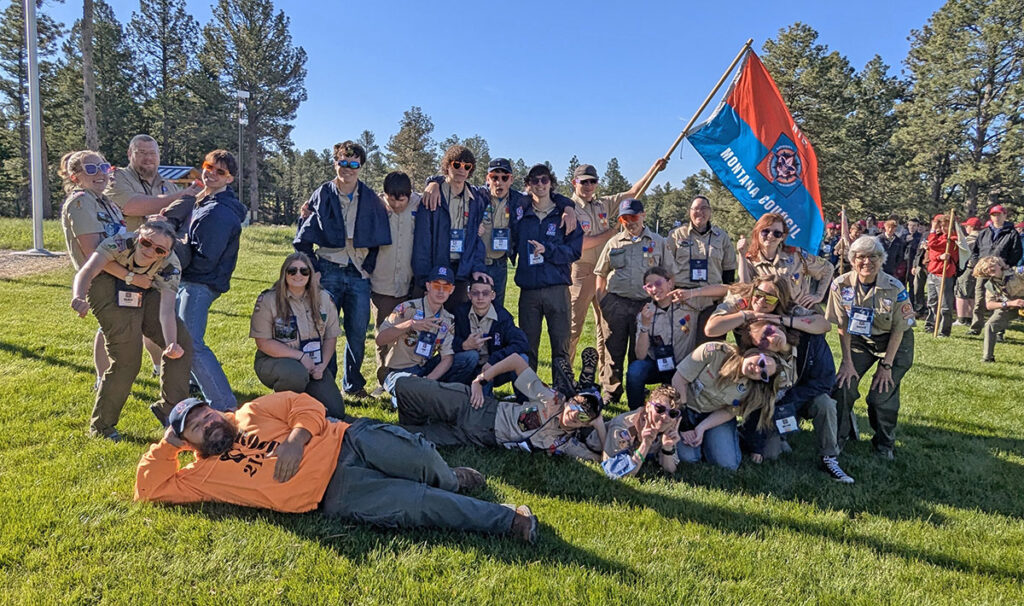Summer is coming, and that means lightning storms can be a risk on any scout outing.
Being aware of the safety risks associated with lighting can help you keep your Scouts safe.
Our friends at the National Weather Service recommend, “When Thunder Roars, Go Indoors!”
According to the weather service’s website, “The only completely safe action is to get inside a safe building or vehicle.”
That advice, however, does not apply to backcountry camping and hiking where we go with Scouts in Montana.
Remember that if you can hear thunder, you are at risk from lighting. That means to take these steps for lightning safety as soon as you hear thunder.
If you are in an area with buildings (like a Scout camp) or cars nearby:
- When you hear thunder, immediately move to a safe shelter like inside a building or inside a car or truck with a metal top and the windows up. You are very safe if you are inside a building or a closed vehicle.
- Do not stand on open porches to watch the storm. Stay inside the closed building and away from windows.
When a Safe Building or Hard-topped Vehicle is Not Close By:
- Remember that there is no safe place outdoors during a thunderstorm. Only safer places.
- You do not have to be under a thundercloud to be a risk from lightning. Lightning can strike up to seven miles from a storm cloud and can happen even when there is blue-sky overhead. Take lightning precautions as soon as you hear thunder.
- You can reduce your risk by making good decisions.
- Plan ahead and get away from places of high danger when you first hear thunder.
- Watch the weather – there is no such thing as a surprise storm!
- Change your mountain summit trip plan and turn around and go downhill if you hear thunder.
- Remember that tents are not safe like a building in a lightning storm. It is important to place your tents in safe areas. Plan on nighttime storms even when the weather is nice in the evening. Storms can happen suddenly in the middle of the night so be prepared and set your camp up to be lightning safe every evening.
- Locate your tent in a low site area. Do not set up tents close to tall trees, on ridge tops, and in open places where your tent is the highest object around.
- We recommend not camping in open areas, but if you have to camp in an open area, pick the lowest spot you can and plan on a route to a safer place lower down than your tents until 30 minutes after the last thunder.
- Talk about lightning safety with your Scouts before every trip and plan to be as safe as possible.
- Do not lie down in your tent in a thunderstorm – sit up in the tent until 30 minutes after the last thunder.
- Never take shelter near or under high trees or lone trees and avoid the edge of lakes/rivers as these areas are more prone to lightning strikes.
- Get off/out of the water and away from the water when you hear thunder.
- Get away from fence lines as fences can conduct electricity from lightning strikes far away.
Last Resort Outdoor Risk Reduction Tips
If you are caught outside with no safe shelter anywhere nearby the following actions may reduce your risk:
- Immediately get off elevated areas such as hills, mountain ridges or peaks.
- Never lie flat on the ground.
- Never shelter under an isolated tree.
- Never use a cliff for shelter or be in the opening of a rocky overhang or cave during a storm.
- Immediately get out of the water and away from ponds, lakes and other bodies of water.
- Stay away from objects that conduct electricity (barbed wire fences, power lines, windmills, etc.).
Scouters: Remember, Hazardous Weather training must be completed prior to you taking your unit in any outing.
The BSA online Hazardous Weather training module presents safety precautions for eight different types of weather, as well as planning, preparation, and traditional weather signs. You will answer questions about the topics after each section. Completion is noted automatically in the BSA training records database if the module is experienced online. Estimated time to complete: 40 minutes.
To take this course, simply log in to My.Scouting.org and take the online training course under E-Learning.
The BSA’s Guide to Safe Scouting has a section devoted to Lightning Risk Reduction. Take time to read it.
Tony Higuera
Chairman
Montana Council Risk Management Committee
Article editor/contributor: Dr. Chris Servheen, Chair Council Conservation Committee




